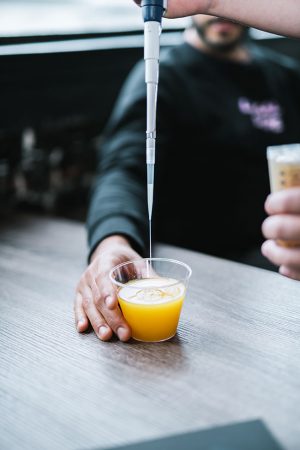
Features
Extraction
Emulsion technology 101
March 1, 2021 By Harold Han
 For entrepreneurs planning to launch an infused product, a clear understanding of the science of emulsion and its applications is fundamental to success in the industry. Photos: Vertosa
For entrepreneurs planning to launch an infused product, a clear understanding of the science of emulsion and its applications is fundamental to success in the industry. Photos: Vertosa Creating high-quality consumer packaged goods (CPGs) requires scientific knowledge and expertise. However, the process becomes exponentially more complicated when an active ingredient such as a cannabinoid like CBD or THC is involved.
Not only does the infused product need to meet all the standards of a regular CPG – such as consistency across batches, scalability while retaining quality, and reliable freshness until consumption (standards that can be made more difficult to achieve by adding cannabinoids) – but it must also deliver on the intended experience.
This additional layer of scientific complexity is where infusion technology comes into play.
What is emulsion technology?
As we all learned in chemistry class, oil and water do not mix because water molecules are hydrophilic, and oil molecules are hydrophobic. Stirring them together can create a temporary blend, but the two liquid bodies will inevitably separate again.
Emulsification is the process that enables these immiscible liquids to stay mixed, producing a homogeneous and stable blend. It employs a compound called an emulsifier, which has both a hydrophobic and hydrophilic component. The emulsifier arranges itself on the oil-water boundary, lowers the surface energy and stabilizes the two phases, enabling the liquids to stay together without repelling each other.
Emulsion technology is used in many of the products that we know and love – from flavoured drinks, to baked goods, to skincare and more. It is also the scientific foundation that enables oil-based cannabinoids to mix seamlessly into our favorite infused products.
What makes cannabis emulsion unique?
Though emulsion technology is quite commonly used in CPGs to deliver a specific taste or appearance, it is not normally needed to deliver active ingredients. This is what makes cannabis emulsions unique. They are the vehicle that enables a change in the consumer’s head space.
This key difference makes cannabis infusion a much more complicated endeavour. While it delivers a seamless mix, the emulsion must also retain and standardize cannabinoid potency. This is much easier said than done, particularly when it comes to infused beverages.
Common challenges
Every infused product has its own unique ingredients, taste, appearance, packaging material, sterilization process and intended experience. Emulsions can run into problems with each of them. Following are some of the common challenges.
Ingredient interaction
Certain ingredients within an infused product may have an adverse chemical reaction with the cannabis emulsion itself, leading to potency loss. Polyphenol, a chemical compound found in grape skin, is a common example of this reaction. Polyphenol naturally bonds with polysorbate, a common emulsifier. This bond can lead to separation within the beverage, causing inconsistent potency and appearance. This reaction has made it a particular challenge to infuse beverages with high levels of polyphenols, such as red wine and pomegranate juice.
Overcoming negative ingredient interactions requires an emulsion provider to identify the problem origin, understand the chemistry of emulsion, and redesign and adapt their formula accordingly.

Emulsion technology had advanced significantly and provides a range of potential for the cannabis industry.
Packaging compatibility
Some emulsions can also run into challenges when put in contact with certain kinds of packaging. For example, the polymer liner on the inside of aluminum cans can attract the hydrophobic oil at the centre of emulsion droplets, causing them to stick to the liner and drain potency from the beverage over time. Polyethylene terephthalate (PET), the hydrophobic polymer used to make most plastic bottles, has a similar effect on emulsion droplets.
Some brands have solved this problem by simply overdosing 30-50 per cent more emulsion or by switching to glass bottles. However, it is possible to reduce potency loss and deliver high-quality product by emulsion engineering and understanding the liner chemistry. An infusion partner should have the scientific capability to deliver an emulsion that is tailored to your vision for the product, including its packaging.
Sterilization
Just like every other packaged beverage sold in the United States, infused beverages must be sterilized for consumer safety. Manufacturers kill any microorganisms that may have been introduced during production, usually with high-temperature thermal processing or with high pressure processing.
However, exposing a poorly designed cannabinoid emulsion to extreme heat or pressure can cause instability, resulting in a loss of homogeneity which then impacts its potency and consistency. Furthermore, high heat or pressure can exacerbate incompatibilities with packaging materials.
When creating an infused product, being certain that the emulsion will withstand all stages of production is critical. An infusion partner should be able to provide proof of the emulsion’s resilience, and if you are working with a process that they have never encountered, they should be prepared to run extensive tests with your product and adapt the formula as needed.
These are some of the most common challenges for creating stable and consistent cannabis emulsions. However, they are not the only ones out there. Every product is different and will encounter a unique combination of obstacles. This is why it is insufficient to use an emulsion that claims to be “one size fits all.” To guarantee a reliable experience, individualized scientific attention and problem solving is essential.
Cannabis emulsion science has come a long way since the early days of bitter, separated and unreliable products. The industry has achieved a point where, with the right ingredient provider, a product maker should never have to sacrifice their vision to achieve a reliable and effective cannabinoid experience.
Harold Han is the founder and chief science officer at Oakland-based infusion technology company, Vertosa. Han holds a PhD in Surface Chemistry from New York University and is the author of two patents in emulsion chemistry.
Print this page